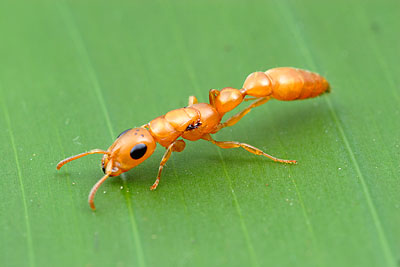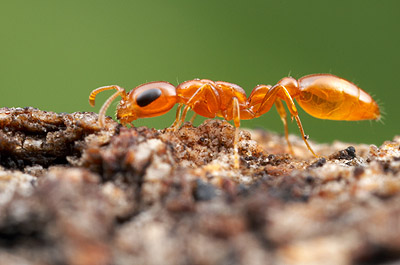
Cataulacus brevisetosus - armored arboreal ant (Africa)

Cephalotes rohweri - armored arboreal ant (North America)

Tetraponera natalensis - elongate twig ant (Africa)

Pseudomyrmex pallidus - elongate twig ant (North America)

Plectroctena mandibularis - giant hunting ant (Africa)

Dinoponera australis - giant hunting ant (South America)

Dorylus helvolus - subterranean ant predator (Africa)

Neivamyrmex californicus - subterranean ant predator (North America)
- Log in to post comments
More like this
Leptogenys attenuata
In spite of the southern winter, the coastal forests of Kwazulu-Natal had plenty of ant activity to keep me occupied last week. In addition to the beautiful Polyrhachis I posted earlier, here are portraits of a few of the species I encountered.
Crematogaster tricolor…
With 12,000 described species, ants dominate global terrestrial ecosystems. Here are a few of them.
Name: Nothomyrmecia macrops
Distribution: Australia
Famous for: The story of its rediscovery (As told by Bill Bryson- scroll down)
Name: Dinoponera australis
Distribution: South America
Famous…
By request, I have now organized the ant photos by subfamily. This mimics the arrangement from the old site. For the smug-muggers out there who want to know how it works, I basically set up an "old journal" gallery and put the genus names and links into the caption box. I used CSS to set all…
Dorylus helvolus, KZN, South Africa
Last night the internet arrived at our new house. I've celebrated the occasion by tackling the backlog of photo uploads.
Over at myrmecos.net the South Africa photos are starting to go up. The first batch covers Dorylus helvolus, a subterranean predatory ant…


Holy ant convergence, batman! I like Cataulacus-- she (?) reminds me of a lucanid.
BTW, the ants in Australia are out. of. control. I encourage you to come back and collect a couple bushels, maybe open up a little niche space for the beetles.
Awesome.
Ever since finding Cataulacus myself, I've been wondering: has anyone tried dropping them out of tree canopies, as has been done with Cephalotes?
Ainsley- Well, I did marry an Australian with the hopes of getting easier access to the aussie ant fauna...
Neil- Indeed.
Sifolinia- When I last talked with Steve Yanoviak (gliding ant guy), we were at ICE in South Africa. He was particularly keen to test out Cataulacus after the meeting. I haven't heard how he went, but I'd be surprised if they didn't glide too.
Myrmecos
I thought you married Jo-anne because of her brains, beauty and her charming Australian parents
Jack Jumper. Um, yeah. That's right. The charming Australian parents. Who have a yard full of charming Australian Ants. ;)
I'm trying to think of other, perhaps less flashy, examples... Let's see:
- Plagiolepis and Paratrechina in the temperate forests of Europe and North America, resp.
- Messor in Northern Hemisphere arid regions and polymorphic, seed-harvesting Monomorium in Australia
- Mound-building grassland Formica in Eurasia and mound-building grassland Camponotus in South America
For Formica, I meant Eurasian and North America, of course. I am thinking of the earth mound builders such as montana, glacialis, and some of the exsecta group.
Cool info!!!
Saw the new Indianna Jones Movie this weekend and my sons were fascinated with the ant scenes and wanted to come and see if there was really anything like that!!